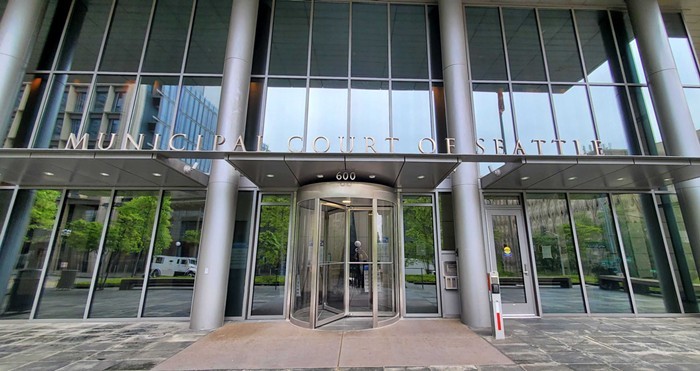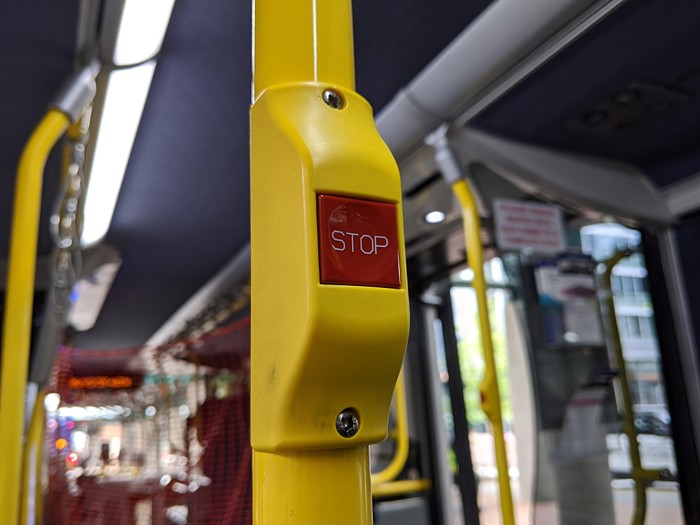I'm no architecture critic, but I'm almost always in favor of the motivated-unlikely. The EMP building, with its forceful curves, majestic proportions, and ludicrous colors, doesn't look like a smashed guitar, as Frank Gehry apparently intended. It looks like a psychedelic giant climbed up the Space Needle, tried to gob the monorail, and missed. I know, I know: It's not the library. It's not supposed to be the library. The library is a requirement. The EMP is supposed to be an experimental interface with rock 'n' roll music, the only major art form that routinely denies being an art form. It's supposed to be a dialogue between a contemporary moment and its brief history, with a hopeful eye on its questionable future.
Best of all, it's supposed to be a safe place to deal with rock music on an intellectual level, which would make it the only such arena in the city--media outlets included. Media outlets especially.
Of course, it's also a place where you can see Gene Simmons' boots or whatever other memorabilia they happen to be displaying in any given exhibit. It's this perceived focus on artifacts--along with the weird building, and the wealth of owner Paul Allen--that has motivated EMP's many detractors (does it have defenders?) to label it a civic embarrassment, an affront to the holy spirit of rock itself. These are silly, ideological arguments, but at least they're based on some kind of conviction. But there's a larger issue that stands between EMP--or any other unorthodox large-scale project--and credibility with the music-loving public in town: Seattle's famous culture of No.
You could cite anything from the rejection of federal funding for mass transit to the rejection of the word "grunge," but I first encountered the "culture of No" when I wrote about a fledgling foundation's attempts to buy an unoccupied mansion on 10th Avenue and convert it into a literary arts center. The neighbors, it seemed, were worried about losing their parking spaces, and so, voted as a community to keep Richard Hugo House out of their backyard. The hostile aversion to EMP among rock people, which started well before the building had been unveiled, and which continues unabated to this day, is born of the same provincial protectionist impulse. Only this time, instead of parking spaces, we're protecting our purist cred.
This is not to say that not liking the EMP is somehow immoral. There's plenty to disapprove of there, and all of it has been exhaustively detailed. What I find vexing, however, in my many experiences as the only one in a room who will admit to not hating the place, is the powerful groupthink that dismisses the entire conception of a museum/inquiry into rock music as inherently lame. "Lame" is the easiest way to assail something, because it shifts the burden of proof to the accused; it's the ultimate hipster shortcut to invalidate an idea that doesn't appeal to you.
None of this would be particularly interesting, however, if the color of people's feelings about EMP weren't such an intense shade of hatred. When I encounter such powerful antipathy, I keep coming back to one question: Who's getting hurt? Hating EMP is like hating the math club: Don't like it? Don't join. But don't blame the math nerds for liking it.
Of course, the math club analogy is pointed; my impression of people's anti-EMP sentiment always detects at least a whiff of nerd-hatred (or self-hatred) alongside the reflexive distrust of the rich. Of the multiple mis-perceptions of the "Project"--a vainglorious rec room for Paul Allen's guitar collection; Hard Rock Cafe-style museum of rock-star swag; and, slightly more accurately, a multimillion-dollar warren where rock critics gather to debate the ineluctable modalities in middle-period Tortoise compositions--all are steeped in cool disdain for the idea that there might be something more to say about rock 'n' roll than "fuck yeah."
I don't love the permanent-collection part of EMP. I think most of Jimi Hendrix's music is soulless garbage. And I'm fundamentally unimpressed by anything designed to cater to the annual gaggle of bovine punters who come to Seattle to photograph the Space Needle. However, I still think the Experience Music Project remains, in theory, a fascinating experiment in joining intellectual energy with music fandom and giving it a budget. Criticize its scale (no, they didn't need the building); its tourist conceits (On Stage is totally indefensible); and even its exhibitions (Disco can suck it). But confess: The idea is interesting.
Still, an interesting idea and $240 million will get you a building everyone in Seattle despises. (More culture of No: If the New York Times had given us permission to hate the library, we'd hate that too.) With that in mind, here are five reasons I can happily defend the Experience Music Project in practice:
KEXP
Without the Experience Music Project, which funded the initial expansion of the on-the-ropes KCMU into a state-of-the-art broadcast facility with boosted signal strength, it's likely that we would have been left without the only radio station worth a tinker's damn in this whole stinking city. With webcasting, event promotion, an ambitious staff, and a great playlist, the broadcast wing of EMP is one of the leading forces in the current counterrevolution against the Clear Channeling of American music culture. Locally and nationally (and internationally), the station has basically invented an audience of intelligent, motivated listeners who actually make an effort to seek out and support new and important music.
Curation
Say what you will about Jimi Hendrix's head mounted on the wall upstairs, the real meat of the EMP's worth lies in the classes, conferences, and youth outreach programs that tourists rarely see. Founded on the seemingly contradictory goals of intellectual ambition and artistic transparency, the curatorial efforts of the EMP staffers have demonstrated significantly more success than the Funk Blast. The Pop Conference is a music nerd Valhalla. It's also the densest concentration of great arts thinkers and writers that Seattle has ready annual access to. The current SongCraft exhibit is full of interesting ideas and displays, and so, frankly, is the Beatlemania room. EMP's work with children, who are typically provided no musical education of any worth by public schools, more than justifies the existence of the organization.
Shows
The Sky Church is an odd (some would say sterile) space to see a band play. It's also the only one in town that can accommodate a major production while maintaining a semi-intimate scale. The sound in the room (to say nothing of on-stage) is so good that it can be alienating to people who think they prefer their PAs shitty. The towering video backdrop is an aesthetic choice. I like it because most rock bands aren't much to look at. More to the point, the Sky Church is the only venue of its kind in the Northwest. If you need a smoky, beer-stained den to make you feel more rock, you have no shortage of options.
The Dylan Exhibit
The upcoming exhibit on the early years of Bob Dylan's self-invention (1956-1966) represents the ultimate test of the EMP both as destination and idea. More than any other artist alive, Dylan represents not just a school or a movement, but an essential paradigm of the form in which he creates. There is no shortage of materials to choose from in examining the Dylan legacy; how curator Ann Powers and company frame his development will largely define where the museum stands as a serious inquiry into music. And whether the Dylan show represents the twilight of EMP as fertile ground for grownups or the beginning of a new morning remains to be seen. I wouldn't even consider missing it.
I also kind of like the building.


















